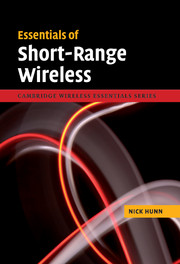Book contents
- Frontmatter
- Contents
- 1 Introduction
- 2 Fundamentals of short-range wireless
- 3 Wireless security
- 4 Bluetooth
- 5 IEEE 802.11abgn/Wi-Fi
- 6 IEEE 802.15.4, ZigBee PRO, RF4CE, 6LoWPAN and WirelessHART
- 7 Bluetooth low energy (formerly Wibree)
- 8 Application development – configuration
- 9 Application development – performance
- 10 Practical considerations – production, certification and IP
- 11 Implementation choices
- 12 Markets and applications
- Glossary of acronyms and abbreviations
- Index
- References
- Frontmatter
- Contents
- 1 Introduction
- 2 Fundamentals of short-range wireless
- 3 Wireless security
- 4 Bluetooth
- 5 IEEE 802.11abgn/Wi-Fi
- 6 IEEE 802.15.4, ZigBee PRO, RF4CE, 6LoWPAN and WirelessHART
- 7 Bluetooth low energy (formerly Wibree)
- 8 Application development – configuration
- 9 Application development – performance
- 10 Practical considerations – production, certification and IP
- 11 Implementation choices
- 12 Markets and applications
- Glossary of acronyms and abbreviations
- Index
- References
Summary
Over the past ten years there has been a revolution in the development and acceptance of mobile products. In that period, cellular telephony and consumer electronics have moved from the realm of science fiction to everyday reality. Much of that revolution is unremarkable – we use wireless, in its broadest sense, for TV remote controls, car keyfobs, travel tickets and credit card transactions every day. At the same time, we have increased the number of mobile devices that we carry around with us. However, in many cases the design and function of these and other static products are still constrained by the wired connections that they use to transfer and share data.
Short-range wireless links have the ability to transform the way that these devices share data, whether that is high-speed streaming, or an occasional indication of a change of temperature. To aid this transition, an enormous amount of work has gone into designing wireless standards and the associated chips and software to support them. Despite this, the task of changing from a cable to wireless is still seen as a daunting prospect by many designers; wireless retains its reputation of being close to black magic. The aim of this book is to demystify wireless and remove some of the misconceptions that continue to surround it, as well as to investigate and explain the new mythologies that these wireless standards have generated.
- Type
- Chapter
- Information
- Essentials of Short-Range Wireless , pp. 1 - 16Publisher: Cambridge University PressPrint publication year: 2010

